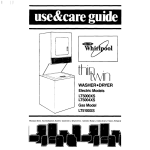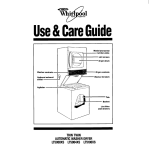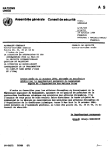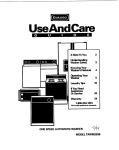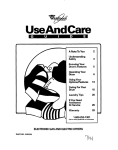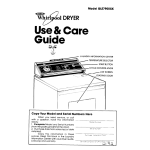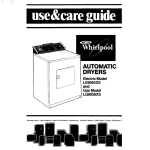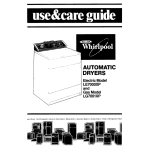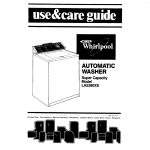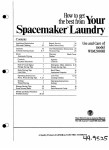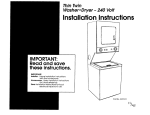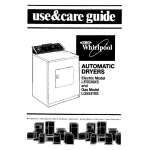Download Whirlpool LT5004XS Operating instructions
Transcript
. thin Win WASHERaDRYER Electric Models LT5OOOXS LT5004XS Gas Model LT51OOXS Microwave Ovens. Trash Compactors. Room AM Condltloners, Dehumldlflers, Automallc Washers, Clolhes Dryers. Freezers, Refrlgerat ! , II Parts and features .,--------\ / / / J MODEL AND SERIAL NUMBER PLATE LINT SCREEN DRYERDRUM WASHERCONTROLS DRYERCONTROLS WASHERLID LATCH OPTIONAL EXHAUST OUTLET LINT FILTER (Not Shown) BASKET AGITATOR TUB Remove the Consumer Buy Guide label. It will be easier to remove before the washeredryer is used. You should wipe out the washer basket and dryer drum with a damp cloth before using to remove dust from storing or shipping. Copy your Model and Serial Numbers here When you need service or call with a question, have this information ready: 1. Complete Model and Serial Numbers (from the plate located as shown). 2. Purchase date from sales slip. Copy this information in these spaces. Keep this book, your warranty and sales slip together in a handy place. Please complete and mail the Owner Registration Card turnlshed with thls product. 2 Model Number Serial Number Purchase Date Service Company Phone Number Contents PARTS AND FEATURES BEFOREUSING YOUR WASHER*DRYER . IMPORTANT SAFETY INSTRUCTIONS . WASHER OPERATING INSTRUCTIONS . . . Starting Your Washer What Happens in Each Cycle .. . OTHER OPERATING INSTRUCTIONS ... For a Rinse and Spin . For a Drain and Spin For a Soak or Pre-Wash Cleaning the Lint Filter DRYER OPERATING INSTRUCTIONS . . . Starting Your Dryer Automatic Cycles . Page 2 3 4 6 6 8 12 12 12 12 13 13 13 14 Timed Drying Selecting a Cycle Gentle Heat .. DRYING TIPS . . FLUFFAIR Setting .. TUMBLEPRESS@ Setting . Mixed Loads . . Drying Times . . . Automatic DRI-MISER@ Control . . LINT SCREEN . LINT REMOVAL. . CARING FOR YOUR WASHER-DRYER . . .. . Cleaning Dryer Interior . Vacation Care . . Winterizing . .. .. IF YOU NEED SERVICE OR ASSISTANCE ... .. WASHER WARRANTY . . . 15 .. 15 15 16 16 16 16 16 . ,. 16 17 17 . .. 18 18 19 19 . . 20 . 24 01987 Whirlpool Corporation Before using your THIN TWIN* washeredryer For best washing and drying results, you must take some very important steps before, during and after each load: 1. Prepare and sort each load for washing, (see your “Laundry Guide”). 2. Measure and add detergent or soap to washer, [see your “Laundry Guide”]. 3. Load the washer properly, (see your “Laundry Guide”]. 4. Select the water temperature, load size and cycle recommended for the fabrics before starting the washer, (see pages 6 and 7). 5. Add other laundry aids to the washer according to instructions, [see your “Laundry Guide”). 6. Properly sort the load for drying, (see your “Laundry Guide”). 7. Select the right drying cycle and time for the fabrics, (see pages 14-16). 8. Remove and hang or fold items lmmedlately after drying. Important safety instructions WARNING - To reduce the risk of fire, electric shock, or injury to persons when using your washer/dryer, follow basic precautions, including the following: Read these laundry Instructions for important use and safety information before using your washer/dryer. NEVER wash or dry items cleanec, wasned, soaked in or spotted with wax, paint, gasoline, or flammaole fluids in the washer. The fumes can create c FIRE HAZARD or EXPLOSION. ALWAYS hand launder and air dry fabrics corstaining these materials. NEVER allow children to operate, pla; wrth, or crawl inside the washer/dryer Close supervision of children is necec-sary when the washer/dryer is usea near children. When discarding an old washerlaryer, ALWAYS remove the lid and door To prevent accidental entrapmer-t NEVERreach into the washer/dryer unt:! all the motion stops. If the lid ISopened while the washer basket is spinning, the basket will automatically stop in a feM secondi. DO NOT install or store washer/dryer where it will be exposed to the weather. DO NOT tamper with the controls. You are personally responsible for making sure that your washer/dryer is Installed, repaired and parts replaced by a qualified person. NEVER use or store flammable fluids (dry cleaning solvents, gasoline, kerosene) in or near your washer/dryer. Do not add flammable fluids to the wash water, The substances give off vapors that can create a FIRE HAZARD or EXPLOSION. use only dryer fabric softeners specifically labeled as not being harmful to the dryer FIRE HAZARD and DAMAGE to materials can result from: * drying rubber, rubber-like and heat sensitive materials with heat. . allowing lint to build-up inside the dryer or exhaust system - cleaning should be done by a qualified person. Clean lint screen before or after each load. WARNING: If hot water has not been used recently (usually two weeks or longer], hydrogen gases may build up in the water heater and the hot water pipes. HYDROGEN GAS IS EXPLOSIVE. To prevent injury or damage, before using your washer, turn on all hot water faucets and allow water to run for several minutes. This will allow gases to escape. Do not smoke or use any open flame near the faucet while it is open. DO NOT let dust, paper, rags, chemicals, etc. pile up around or under the washer/dryer. The washer/dryer must be electrically grounded. See the “Installation Instructions: - SAVE THESEINSTRUCTIONS - 4 Additional Safety Instructions ALWAYS shut off the gas valve before leaving on vacation. unplug the power supply cord before attempting to service the washer/dryer. Shut off GAS VALVE if yours is a gas dryer. ALWAYS and Your Responsibilities NEVER operate the washer/dryer l it IS not working right l it is damaged. l parts are missing. 9 all panels are not in place. if... You are personally responsible for l FOR YOUR SAFETYl making sure that your washer/dryer: IF YOU SMELL GAS: l is properly maintained. 1. OPEN WINDOWS. l is properly installed and leveled in a 2. DON’T TOUCH ELECTRICALSWITCHES. well ventilated room on a floor that 3. EXTINGUISHANY OPEN FLAME. can support the weight.* 4. IMMEDIATELYCALL YOUR GAS l is located in an area where the temSUPPLIER. perature is above 45°F (7.2”C) because... DO NOT machine wash glass fiber -the dryer will not operate properly materials, Small particles can stick to at cold temperatures. fabrics washed in following loads and cause skin irritation. - freezing temperatures can damage the washer. HAZARDOUS FUMES can be formed if l is connected to the proper electrical chlorine bleach is used in the same supply, outlet, water supply, plumbing wash as ammonia or acids such as vinfixtures, drain, and dryer exhausting egar or rust remover. svstem.* ALWAYS store detergent, laundry aids l is’ not installed against drapes or and other materials in a cool, dry curtains.’ place where children can’t reach them l is used only for jobs normally ex- in a locked cabinet if possible. pected of home automatic washer/ dryers. ALWAYS read and follow instructions on packages of detergent and laundry ‘Refer to the “Installation Instructions” aids - especially warnings and for complete information. precautions. Washer operating instructions Starting Your Washer Be sure to measure and add detergent, then place a sorted load in the washer before starting it. 1 . Select a LOAD SIZE Turn the knob to point at a setting that describes the size of load you want to wash. l The washer can be set for EX SMALL, MEDIUM or LARGE loads. Select the water level that matches the load size. See your “Laundry Guide” for details on load sizes. l 2 Select . WATER TEMPERATURES Match the wash water temperature to the type of fabrics and soils being washed. Recommended wash temperatures can be found in your “Laundry Guide.” l LOAD SIZES AND WATER LEVELS For best cleaning results, the load must be able to move freely in the water. Too big a load or too little water can cause wear or tearing of load items. CAUTION: DO NOT OVERLOAD WASHER LARGE (11.3galJ42.7 L)* MED : (8.5 galJ32.1 L)’ 2siiT EX SMALL (5.6 gal.Bl.2L)’ *Approximate fill with load. : I I I’ 3. Select CYCLE and WASH TIME; Start the washer A. Push in the Control Knob and turn it to the right. It must be pushed in and turned only clockwise. 6. Stop on a number in the cycle you want. The numbers are minutes of wash time. The drawing shows 8 minutes of agitation in the REGULARNORMAL Cycle. C. Start the washer by pulling out D. To stop the washer at any time, the control knob. The washer will fill to the level you set with wash water of the selected temperature. After filling, the washer will agitate for the selected number of minutes. push in the Control Knob. To restart the washer, pull out the Control Knob. What Happens in Each Cycle* Each cycle has different agitation and spin speeds designed for different kinds of fabrics. Numbers on the dial in each cycle are the minutes of WASH agitation time. When the Cycle Control Knob is set to a number and pulled out, the washer fills before agitation and timing starts. After agitation starts, the knob REGULAR HEAVY Cycle A cycle for sturdily constructed fabrics that are heavily soiled. REGULAR NORMAL Cycle A cycle for sturdily constructed fabrics that are moderately soiled. PERMANENT PRESS Cycle 7 WASH 8 Minutes Low Speed REFILL A special cycle with the necessary cool-down rinse which helps keep wrinkles from setting into Permanent Press and some synthetic fabrics. 8 COOL DOWN turns clockwise until it points to OFF and the cycle ends. NOTE: You may hear the sound of water spraying during the spin parts of some cycles. In some cycles, cold water is sprayed on the spinning load to help with the rinsing. Genlie Wash System For better fabric care in the REGULARand PERMANENTPRESScycles, the agitation speed is reduced during the last few minutes of wash time. RINSE Low Speed RINSE LOW Speed NOTE: Always use cold rinse water for permanent press fabrics. 9 KNITS/GENTLE Cycle A cycle that gently washes and spins delicate items and washable knits. Alndicates the machine is pausing for a brief soak period. SOAK and PRE-WASH Cycles Brief periods of agitation and soak time help remove heavy soils and certain stains that need extra pretreatment. Use recommended amount of detergent. The SOAK Cycle should always be followed by a Wash Cycle. SUPER WASH Cycle Use for washing heavily soiled loads that require maximum soil removal. Double the amount of detergent recommended when uslng the SUPERWASH Cycle. 10 1 Pre-wash setting begins here. (See page 121. Special care is needed when soaking or pre-washing See your “Laundry Guide” for proper use of this cycle. laundry After the Partial Drain, the washer automatically refills and goes in the REGULAR/HEAVY Cycle. Be sure to use enough detergent for the double wash. 11 Other operating instructions For a rinse and spin For a drain and spin You may need an extra rinse and spin for heavily soiled loads which need more detergent. (Extra detergent can require an extra rinse.) 1. Push Control Knob in. 2. Turn clockwise to any l on the dial. See above drawing. 3. Pull Control Knob out. The washer will fill to selected level; agitate 2 minutes; drain and spin. Your washer can be set to drain and spin out water. 1. Push Control Knob in. 2. Turn clockwise to the bar just before the OFF area in any cycle. See above drawing. 3. Pull Control Knob out. The washer will drain and spin. For agltatlon and spin speeds In each cycle, see pages S-11. For a soak or pre-wash For best results, use warm water for soaking or prewashing stained laundry. Hot water can set stalns. 1. Use recommended amount of detergent or pre-soa k product. 2. Push Control Knob in. 3. Turn clockwise to point at a number in the SOAK or PREWASH Cycle. 4. Pull Control Knob out. The washer will start. 5. When the cycle is over, add detergent for the next selected wash cycle. The SOAK Cycle should always be followed by a Wash Cycle. Important: See addlftonal care lnformatlon In your “Laundry Guide!’ To start the soak or pm-wash with agitation, the Cycle Control Knob must point to a number. 12 Cleaning the lint filter Clean filter after every load for best filtering results. NOTE: The load type will vary the amount of lint build-up. To clean: 1. Lift off the agitator barrel. 2. Wash or wipe the filter clean in the bottom of the agitator barrel. The filter is not removable. 3. Replace the agitator barrel and snap into place. Dryer operating instructions Starting Your Dryer Before starting your dryer, be sure laundry is sorted and loaded properly, (see your “Laundry Guide”]. Be sure the door is tightly closed. 1. Select CYCLE and TIME Turn the Control Knob either way to point to the time setting you want in the cycle you want. 2 n Push the START Button The dryer will start fumbling when you push the STARTButton. continued on next page 13 3. To Stop and Restart the Dryer 4. Changing the Setting The setting can be changed at any time by turning the Control Knob to a new setting. The Cycle Control Knob should polnf to an OFF area when the dryer Is not Is use. If the dryer Is stopped before the cycle Is finlshed, turn the Cycle Control Knob to an OFF area. To stop, open the door (or turn the Control Knob to the OFF area). To restart, close the door and push the STARTButton. The automatic cycles The automatic cycles allow you to select the degree of dryness you prefer for the clothes being dried. The Cycle Control Knob will not move until the clothes load is almost dry, or the COOL-DOWN portion of the cycle has been reached. After COOL-DOWN, the knob automatically moves to an OFF area and tumbling stops. Use AUTOMATIC REGULARto dry heavy and mediumweight cotton items. The load fumbles wlfhout heat during the last 5 minutes. This heIDS make the load easier to Use AUTOMATIC PERMANENT PRESSto dry permanent press, knits and other synthetic fabrics. The load tumbles wlfhout heat durlng the last 10 mlnutes. This helps keep wrinkles from setting in, and makes the load easier to handle. 14 For the first few loads, set the Control Knob to point to an * in either automatic cycle. When the dryer stops, feel the dried items. l l If Items are drier than you like, use a setting to the right if the * the next time you dry a similar load. If items are not as dry as you like, use a setting to the left of the * the next time you dry a similar load. Tied drying Use the TIMED DRYING Cycles for any load you want to dry by time. l Turn the Control Knob to the number of minutes you want-from 10 to 50. l The last 10 minutes of this cycle are without heat - a cool-down time. This helps make the load easier to handle. Selecting a Cycle SUGGESTED CYCLE TYPEOF LOAD COTTON - Unens .. EXTRAHEAW - Bedspreads, mattress pads, qullts HEAVYWEIGHTFABRICS-Towels, jeans, corduroys, workclothes...................................... MEDIUMWEIGHT COTTONS-Sheets, pillowcases, cotton underwear, diapers. . . . . . . . . . , . . . . . . . . . . . . LIGHTWEIGHTCOTTONS - Batlstes, organdies, lingerle AUTOMATIC REGULAR PERMANENT PRESS,SVNTH~ICS AND BLENDS HEAVYWEIGHTFABRICS-Work clothes, Jackets, mlncoats......................................... MEDIUMWEIGHT FABRICS-Shirts, play clothes, sheets,slacks..................................... LIGHTWEIGHTFABRICS- Llngerie, blouses, dresses . . . . AUTOMATIC PERMANENT PRESS KNITS HEAVYWEIGHT- Cottons, myons, blends, T-shirts, slacks,shirts . . . . . . . . . . . . . . . . . . . . . . . . . . . . . . . . . . . . . . LIGHTWEIGHT- Synthetics (polyester, acrylic, etc.) and blends, Ilngerle, blouses, dresses . . . . . . . . . . . . . AUTOMATIC PERMANENT PRESS LIGHTWEIGHT AND DELICATE FABRICS Sheer Curtalns (2 or 3 panels) . . . . ... Gauze, lace, etc. . . . . . . . . . . . .. ....... . ....... RUBBER,PLASTIC, HEAT-SENSITIVEFABRICS FCAM RUBBER- Pillows, bras, stuffed toys . . . . . . . . . . . . PLASTIC- Shower curtatns, tablecloths . . . . . . . . . . . . . OLEFIN,POLYPROPYLENE, SHEERNYLON . . . . . . . . . . . . . . . AUTOMATIC PBRI;IsENT FLUFFAIR 20 MIN. 20 MIN. 15-20 MIN. Gentle Heat The dryer automatically reduces the heating settings in the automatic cycles. During the last few minutes of these cycles the dryer gradually reduces to a lower heat setting. This helps prevent overdrying. 15 Drying tips The dryer does not heat when the Control Knob is set on FLUFFAIR. This setting can be used to fluff bedding, plastic tablecloths, foam rubber pillows, stuffed toys, sneakers, etc. TUMBLE PRESS” Setting The TUMBLEPRESSsetting removes wrinkles from dry clothing such as items that may have been packed in a suitcase, closet, or items not removed from the dryer. The load will tumble in heated air for 10 minutes. The heat shuts off and the dryer continues to tumble the load for 5 more minutes. For best results, TUMBLEPRESS only a few items at a time. Put them on hangers or fold them as soon as the dryer stops. Mixed loads When drying a load with different kinds and weights of fabrics, use the cycle suggested for the lightest fabrics. When the dryer stops, ’ remove dry items and reset the control. To help reduce wrinkles, take the load from the dryer as soon as tumbling stops. This is very important for permanent press, knits and other synthetic fabrics. Automatic DRY-MISER” Control Drying times Drying times will vary depending on: amount of moisture in the clothes. l type and weight of the fabric. l size of the load. l room temperature around the dryer. l temperature of the wash rinse water. l amount of lint in the lint screen. l dryer temperature selection. l See your “Laundry Guide” for more information. The thermostat senses the air temperature. The dryer automatically dff when the selected dryness is reached. 16 shuts Lint screen Clean the lint screen before each load. A screen blocked by lint can increase drying time and may be a FIREHAZARD. The lint screen is inside the dryer drum, on theback wall. 1. Use the finger holes to pull the .lint. .screen . srralgnr OUT. 2. Lightly squeeze the body, as shown, while pulling the cover off. 3. Roll lint off the screen with your fingers. Squeeze body ; DO NOT rinse pull cover off. or wash the screen. Wet lint is hard to remove, 4. Replace the cover on the body of the lint screen. 5. Push the lint screen straight back in until it clicks into place. Lint removal Lint can gather inside the dryer and create a FIRE HAZARD. This lint should be removed at least every 2 to 3 years, or more often, depending on dryer usage. Box Heat Element Terminals ELECTRICDRYERS Cleaning should GAS DRYERS be done only by a qualified WARNING: l Avoid electrical shock hazard - unplug power supply cord or turn off 0 electrical power. l Avoid InJury or damage - do not put hands inside cabinet. l Make sure dryer is cool. person. 1. Remove back panel from dryer. 2. Avoid touching wires and thermostats. 3. Remove lint from shaded area see art- with a soft brush or vacuum cleaner. 4. Replace back panel, reconnect and relevel the washer/dryer. 17 Caring for your washeredryer Sharp or heavy objects should never be put on or in the washer or dryer. Check pockets for bolts, When not washing, keep both water faucets turned off. This takes the pressure off the water inlet valve and hoses. Never soak l soak l soak 0 soak l use the washer to... for more than 2 hours. with chlorine bleach. with vinegar or other acids. or store urine soaked clothes, Some pretreatment products can damage dials, consoles and finish. Do not use these products on or near your washer or dryer. Cleaning dryer interior Never leave or store wet, damp or dry laundry in your washer or dryer. Garments which contain unstable dyes, such as denim blue jeans or brightly colored cotton items, may discolor the dryer interior. If the interior is discolored, clean with one of the following methods to avoid staining later load items. After washing, use a soft dry cloth to wipe the outside and inside dry. Leave washer lid up until the basket is dry Wipe up all spills. Spills allowed to remain may dull or damage the finish. Remove loose and sharp objects from pockets and cuffs before washing or drying - pins, buckles, etc. Close metal zippers. 18 Powdered laundry detergent and very warm water Make a paste with detergent and very warm water. Apply paste to a soft cloth and scrub area until all excess dye is removed. Wipe thoroughly with a damp cloth Tumble a load of rags-ORliquid spmy household cleaner Spray on stained area. Rub with a cloth until all excess dye is removed. Tumble a load of rags. Vacation care 1. Turn off both water faucets to take pressure off inlet valves and hoses. 2. Unplug power supply cord or turn off electrical power supply. 3. Clean lint screen and lint filter. Winterizing Install and store your washer/dryer where it won’t freeze. Because some water stays in the washer, freezing can damage it. If your washer/ dryer is stored or moved during freezing weather, winterize it. 1. Shut off both water faucets. Disconnect and drain water inlet hoses. To use the washer 2. Put a quart of R.V or automobile type antifreeze in the basket. again... 1. Flush water pipes and hoses. 2. Reconnect water inlet hoses. 3. Turn on both water faucets. 3. Run washer on a drain and spin setting (see page 12) for about 30 seconds to mix antifreeze and water. 4. Run the washer through a complete cycle with one cup of detergent to clean out the antifreeze. 19 If you need service or assistance, we suggest you follow these five steps: 1. Before calling for assistance... The drain hose should not fit tightly in the drain pipe. l Make sure that the Cycle Control Knob is pointing to a number in the cycle. Make sure the dmln hose Is hlgher than the wafer level in the washer. If if Isnt.. l The washer may seem to be draining during wash and rinse cycles. l Water can siphon out. (See “lnstallation Instructions:‘) If your washer stops durlng a cycle: l Remember, the washer pauses briefly at different times in each cycle. These pauses are normal. If your dryer does not run or heat: l Is the power supply cord plugged into a live circuit with the proper voltage? l Is the door closed tightly? l Did you push START? l Have you checked your home’s main fuses or circuit breaker box? l The FLUFF AIR setting is without heat. l The last minutes of heat settings are without heat. See page 14. l Is the gas turned on? If not, turn the Control Knob to OFF. Turn on gas. Wait 5 minutes. Reset controls and start. If drying ffmes seem too long: l Performance problems often result from little things you can find and fix yourself without tools of any kind. If your washer does not till: Is the power supply cord plugged into a live circuit with the proper voltage? l Are both water faucets open? l Have you checked your home’s main fuses or circuit breaker box? l Are the water supply hoses kinked? l Is the Cycle Control Knob set and pulled out? If your washer does not spin: l Is the lid closed? l Is the power supply cord plugged into a live circuit with the Drover l Have you checked your home’s main fuses or circuit breaker box? If your washer dmlns af the wrong flme: l The drain hose should be at least 28 Inches above the floor and secured. 20 l l l Is the lint screen clean? See page 17 of this book for cleaning instructions. See page 16 of this book and your “Laundry Guide:’ 2. If you need assistance?.. Call Whirlpool COOL-LINE” servIce assistance telephone number. Dial free from anywhere In the U.S.: l-800-253-1301 and talk with one of our trained Consultants. The Consultant can instruct you in how to obtain satisfactory operation from your appliance or, if service is necessary, recommend a qualified service company in your area. 3. If you need service?.. Whirlpool has a nationwide network of franchised TECHCARE’ Service Companies, TECH-CARE service technicians are trained to fulfill the product warranty and provide after-warranty service, anywhere in the United States. To locate TECH-CAREservice in your area, call our COOL-LINE service assistance telephone number (see Step 2) or look in your telephone directory Yellow Pages under: 4. If you have a problem?.. Call our COOL-LINE service assistance telephone number (see Step 2) and talk with one of our Consultants, or if you prefer, write to: Mr. Robert Stanley Division Vice President Whirlpool Corporation 2000 M-63 Benton Harbor, Ml 49022 5. If you need FSP” replacement parts?. . FSP is a registered trademark of Whirlpool Corporation for quality parts. look for this symbol of quality whenever you need a replacement part for your Whirlpool appliance. FSP replacement parts will fit right and work right, because they are made to the same exacting specifications used to build every new Whirlpool appliance. ‘If you must call or write, please provide: model number, serial number, date of purchase, and a complete description of the problem. This information is needed in order to better respond to your request for assistance. 21 Notes 22 Notes 23 WHIRLPOOL” “THIN TWIN” WARRANTY LENGTH OF WARRANTY FULL ONE-YEAR WARRANTY From Date of Purchase LIMITED FOUR-YEAR WARRANTY Second Through Fifth Year From Date of Purchase WHIRLPOOL 1 WHIRLPOOL WILL PAY FOR - FSP@replacement parts and repair laborto correct defects in materials or workmanship. Service must be provided by a franchised TECH-CARE@service company. FSP@replacement parts for any part of gearcase assembly if defective in materials or workmanship. The gearcase assembly is shown below. WlLL NOT PAY FOR A. Service calls to: B. C. D. 1. 1. Correct the installation of the washer/dryer. 2. Instruct you how to use the washer/dryer. 3. Replace house fuses or correct house wiring or plumbing. 4. Replace Ilght bulbs. Repairs when washer/dryer is used in other than normal, single-family household use. Pick up and delivery. This product is designed to be repaired in the home. Damage to washer/dryer caused by accident, misuse, fire, flood, acts of God or use of products not approved by Whirlpool. Any labor costs durlng the llmited warranty. WHIRLPOOL CORPORATION SHALL NOT BE LIABLEFOR INCIDENTAL OR CONSEQUENTIAL DAMAGES. Some states do not allow the exclusion or limitation of Incidental or consequential damages so thls llmitation or exclusion may not apply to you. This warranty gives you specific legal rights, and you may also have other rlghts which vary from state to state. Outside the United States, a different warranty may apply. For details, please contact your authorized Whirlpool distributor or milftary exchange. GEARCASE ASSEMBLY COVERED BY YOUR WARRANTY Part No. 3388935 01987 Whirlpool Corporation Printed in U.S.A.
























